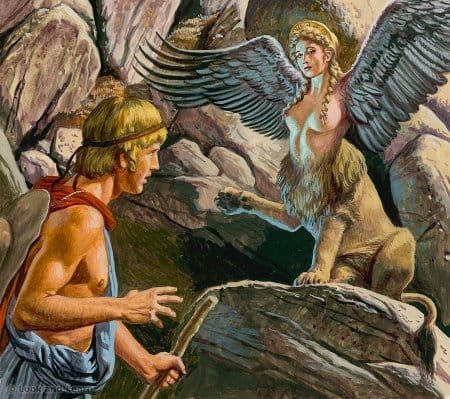The Chariot card in the Tarot deck is often linked to the story of Oedipus, a Greek Myth about a king who fulfilled a gruesome prophecy by killing his own father and subsequently marrying his own mother. Sigmund Freud has also immortalized this story by coining the words ‘Oedipus Complex’ to define an unconscious desire within the mind of a boy to kill his father and marry his mother.
The picture of the Chariot card might not really talk about the entire story of Oedipus, but a part of it is certainly reflected in the image. So let’s look at the story of Oedipus, and which part of it relates to the Chariot card and how.
The Story Of Oedipus: Birth and Prophecy
Oedipus was born to the King and Queen of Thebes, Laius and Jocasta. They had been married for several years and were childless. So  King Laius decided to consult the Oracle at Delphi, who prophesied that eventually he would have a son, but then that son would grow up to kill him. So when Jocasta eventually did have a son, Laius had his ankles pinned together so that the child wouldn’t be able to crawl.
King Laius decided to consult the Oracle at Delphi, who prophesied that eventually he would have a son, but then that son would grow up to kill him. So when Jocasta eventually did have a son, Laius had his ankles pinned together so that the child wouldn’t be able to crawl.
Incidentally, the meaning of the name ‘Oedipus’ owes its origins to the Greek word Oedema / Edema, which means ‘swelling of the ankles’.
Anyhow, with his ankles pinned together, Jocasta gave the baby to a servant so that he may abandon the baby on a mountain. But the servant felt sorry for the baby, and gave the child to a shepherd from Corinth. This shepherd then passed the baby to another shepherd. Eventually, he was adopted by the King and Queen of Corinth, Polybus and Merope. They were childless and were happy to have the baby in their house.
The Story of Oedipus: Discovery and Adventure
Many years passed, and Oedipus grew up to be a fine young man, happy with his father and mother, Polybus and Merope. But, the adventure has to have a start somewhere, right?
 So one fine evening, a drunk man told Oedipus that he wasn’t the true son of Polybus and Merope, and was, in fact, adopted. When Oedipus confronted Polybus and Merope, they denied it. But the doubts had already set in, and Oedipus sent a request to the Oracle at Delphi to look into it and reveal the truth to him.
So one fine evening, a drunk man told Oedipus that he wasn’t the true son of Polybus and Merope, and was, in fact, adopted. When Oedipus confronted Polybus and Merope, they denied it. But the doubts had already set in, and Oedipus sent a request to the Oracle at Delphi to look into it and reveal the truth to him.
The Oracle replied in her own cryptic way (which was pretty standard for Oracles by the way…). And although she didn’t tell him about his true parents, she did say that he was destined to kill his own father and marry his own mother.
When Oedipus heard the Oracle’s message, he was quite disturbed (naturally), and decided to leave Corinth forever. He figured that if he left, he would avoid the gruesome destiny that lay in wait for him. Out of Corinth, he decided to go to Thebes instead.
The Story of Oedipus: Fulfilling The First Prophecy
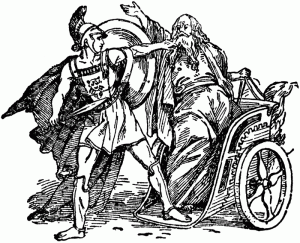 As Oedipus travelled along to Thebes, he ended up at a place where 3 roads crossed each other. While wondering which road to take, he happened to encounter an older man in his chariot. They ended up having an argument over who had the right to go first (apparently the road was quite narrow), and in the ensuing argument and fight, Oedipus killed the old man. The only witness was a slave, who then ran away.
As Oedipus travelled along to Thebes, he ended up at a place where 3 roads crossed each other. While wondering which road to take, he happened to encounter an older man in his chariot. They ended up having an argument over who had the right to go first (apparently the road was quite narrow), and in the ensuing argument and fight, Oedipus killed the old man. The only witness was a slave, who then ran away.
Little did Oedipus know that the old man whom he had killed was none other than Laius, his birth father. Unwittingly, Oedipus had fulfilled the first part of the Prophecy.
The Story of Oedipus: The Riddle of The Sphinx
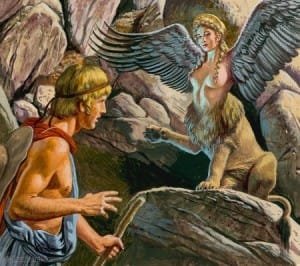 In any case, Oedipus went on ahead to Thebes. But at the gates of the city he met a Sphinx.
In any case, Oedipus went on ahead to Thebes. But at the gates of the city he met a Sphinx.
This Sphinx ruled the city of Thebes, and had a nasty habit of stopping people on the road and asking them riddles. If they were able to answer, then they could go on ahead. But if they weren’t able to answer, then, well, then they would be the Sphinx’s dinner.
The Sphinx put a riddle to Oedipus. “What walks on four feet in the morning, two in the afternoon and three at night?” she asked. Oedipus was a smart fellow, and quickly gave the answer. “Man,” he said, “because he crawls on his hands and knees as an infant, walks on two legs as an adult, and uses a walking stick when he grows old.”
The Story of Oedipus: Fulfilling The Second Prophecy
The Sphinx was mighty pleased with Oedipus’ answer, and for some reason threw herself into the sea, killing herself. Thus, Oedipus not only solved the riddle, but also freed the people of Thebes.
So, when he went into the city, everyone cheered him up and celebrated their freedom. And because they were so happy, they also offered him the hand of their recently widowed Queen in marriage. That Queen was Jocasta.
When Oedipus married Jocasta, he fulfilled the second and final part of the prophecy. Of course, he had no idea that he had.
In fact, he seemed to have a decent married life with his new queen, and even had four children with her – two sons, Eteocles and Polynices, and two daughters, Antigone and Ismene.
The Story of Oedipus: Troubles and Revelations
Many years passed without much incident, and then trouble struck. Thebes was plagued by infertility. Crops stopped growing in the fields and women didn’t bear any children. Oedipus sent his brother-in-law Creon, to the Oracle at Delphi asking for guidance.
When Creon returned he revealed what the Oracle had told him. “Find the killer of Laius,” the Oracle had said, “and kill him or exile him!” All that was fine, but no one knew the identity of Laius’ killer. So Creon suggested that they consult a blind prophet, Tiresias, who lived in Thebes.
Oedipus sent for Tiresias. But he warned Oedipus not to search for the person who killed Laius. Of course, this resulted in a huge argument, whereupon Tiresias finally revealed that Oedipus himself was the killer of Laius, and that Oedipus had no idea who his real parents were. Angry at Tiresias’ words, Oedipus accused Creon of lies and falsehood. They ended up having an argument between them.
Jocasta tried to intervene, and told Oedipus the story of her first-born child who had been abandoned to die.
But, Oedipus just wasn’t interested in all that. He felt that he was in fact guilty of killing Laius, and was the cause of the plague of infertility in the kingdom.
Right about then, a messenger arrived from Corinth with the news of King Polybus’ death. Oedipus was saddened, but he was also secretly relieved that he hadn’t ended up killing his father. But because his mother was still alive, he refused to attend the funeral, because he didn’t want to be in any position where he might end up fulfilling the rest of the prophecy.
But, as luck would have it, the messenger from Corinth tried to ease Oedipus’ troubled mind by telling him that Polybus and Merope had actually adopted him.
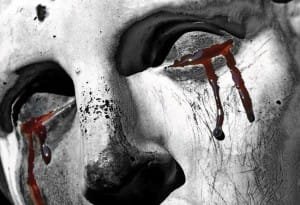
It was at this point that Jocasta realized the Oedipus was her first-born son! She begged him to stop all the searching. But Oedipus misunderstood her pleas. He thought that Jocasta was now ashamed of him because she thought him to be the son of slaves. So Oedipus began his search for the truth – he found the servant who was to leave him at the mountain, and from there discovered the shepherd and so on, till he discovered the awful truth.
The Story of Oedipus: The Sad, Bitter End
Jocasta, meanwhile, went to her palace and hanged herself. When Oedipus discovered her like that, he took a pin from her brooch, and used it to gouge his eyes out. Naturally, he was also exiled from Thebes.
He spent the rest of his days roaming around the countryside, accompanied by his daughter Antigone, till he finally died.
The Story of Oedipus: And What Happened In Thebes?
Back in Thebes, the 2 sons of Oedipus decided to share the kingdom between themselves, alternating their rule every year. But after his year on the throne, Eteocles refused to let Polynices rule. So Polynices put together his army to battle Eteocles and oust him from the kingdom. In that battle, the two brothers ended up killing each other.
So, Creon, Jocasta’s brother, ended up becoming the King of Thebes. He decreed that Polynices was a traitor, and wouldn’t be given any burial rites. But when Antigone decided to give her brother a proper burial, Creon had her buried in a rock cavern, where she hanged herself.
The Story of Oedipus
Overall, the story of Oedipus is a tragic portrayal of a man who fought to defy his destiny, but unknowingly falling prey to it, and fulfilling it anyway. No matter what he did, and where he went, he was unable to escape from Fate’s macabre noose, which tightened around his neck the more he tried to cut it loose.
Does this story, then, try to tell us that Fate or Destiny is inevitable? That, no matter where we go, we can’t escape her clutches? That, perhaps, even this trying to avoid or running away from it, is also inexplicably a part of the fulfillment process? It certainly is something to think about, isn’t it? 🙂
Oedipus and the Chariot card
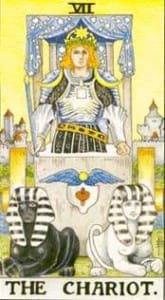
If you look at the picture of the Chariot card, you will see a young man, standing tall in his chariot, with two sphinxes leading the way. He stands victorious, having defeated all the hurdles in his path, becoming successful and strong willed by his experience.
It is here that we see Oedipus standing at the gate of Thebes. He has not only killed King Laius before, but he has also answered the Sphinx’s riddle, freeing the Thebans from her oppressive rule.
It is here, that we see Oedipus in full glory – as a man who sought to make his way in the world, and was successful in his venture.
In the Major Arcana, the Chariot represents such a stage in the development of the human psyche as well – after conquering the challenges posed by the previous cards, here is a young man who stands at the peak of his success, ready to take charge and rule his kingdom!
We see many of these take charge qualities in the character of Oedipus too – although his primary desire was to not fulfill his destiny as per the Prophecy, he didn’t sit and mope around about it. Nor did he choose to give in to the Fates as it were. He decided to go out into the world, and try his luck. It is unfortunate, though, that his adventures did in fact lead him on to fulfilling the Prophecy.
Your Turn…
What did you make of the story of Oedipus? Do you have any thoughts of your own to add? Do share them in the comments box below.

